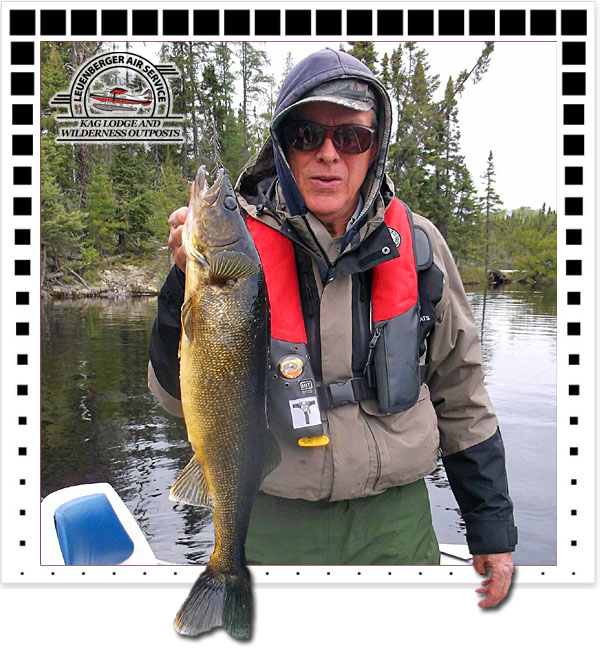


Fly-in Walleye Fishing North of Nakina, Ontario

All of our lakes have outstanding fishing for Walleye. The structure of all our lakes produces perfect conditions for large populations of Walleye to thrive. There are streams and river currents as well as sandy areas, which give the Walleyes prime spawning grounds. Feeder streams are constantly refreshing the lakes with oxygen as well as carry nutrients. A diverse number of weed species such as Lily Pads, Bulrushes, Wild Rice, Musky Cabbage, Raccoon Tail and Pickerel Weed not only give the Walleyes cover from Northern Pike; they provide feeding grounds as the minnows and other food are attracted to the weeds. Our lakes also exhibit islands, shoals and rocky points, which generally attract the bigger Walleyes because they want quick access to deeper water.
On an average day (fishing in the right spots with the right bait) you should catch between 50 and 80 walleyes. Fishing experience and knowledge of the lake will influence your success. We have many customers that catch over 100 Walleyes in a day. Average size in a lake vs. average catching size is a conundrum. Bigger & deeper lakes generally produce bigger fish but those bigger fish have deeper water to hide in. On a smaller shallow lake the average size might be smaller but the big Walleyes only have weeds in shallower water to hide in so they are more accessible. Generally most of the Walleyes you will catch will be 2 to 3 pounds. During a week of targeting Walleye you should catch many in the 4 to 7-pound range. Our lakes have plenty of big 30+" trophies. Your best chance of getting a trophy is in the spring while the big females are right up close to shore for the spawn. To get a trophy in the summer you would need to fish at least 20' deep or troll along weed lines in the evening that are close to drop-offs into deeper water. The big Walleyes do come out of the depths in the evening and head to shallow water to feed.
The feeding habits of all fish are affected by weather conditions. Wind speed, wind direction, atmospheric pressure, sunlight, moonlight and temperature are all factors. Some conditions will throw them into a feeding frenzy while other conditions will cause them to slow down.
Wind Speed and Direction:
A hot sunny day with no wind makes for tougher Walleye fishing. They will go deep or sit right on bottom in the weeds. If you are fishing one of our shallower lakes then put a twistertail on a hook (not a jig) and tip it with a tiny bit of worm and cast out, let it sink to the bottom and drag it across the bottom. That will produce results in less than desirable conditions.
When it's windy the waves break up light penetration so the Walleyes will come out of the weeds and deep-water fish will come shallower. A windy and wavy day is when the biggest fish get caught. You also need to follow the wind because fish do. If you have moderate size waves and they are rolling up onto structure such as an island, shoal or rocky point; fish the windy side. If there are really big waves then the oscillation of the water becomes annoying to fish so fish on the sides of structure or a little deeper.
 Atmospheric Conditions:
Atmospheric Conditions:Every lake is different. On some lakes (usually shallow weedy lakes) overcast and low pressure weather can cause the Walleyes to go into a feeding frenzy while on other lakes (deep lakes) the fish go deep to compensate for the low pressure. Before and after a thunderstorm is when they go into a feeding frenzy. The Walleyes usually stop feeding during heavy rain but on some occasions, during the heat of the summer, a cold rain cooling down the surface water will drive minnows up close to the surface and the Walleyes follow to take advantage of the feast.
Lures and Colors:
If you are fishing tea-stained water you will want to go with brighter colors such as white, pink, chartreuse, neon green or neon orange. Most of the time in the shallow lakes you only need a pink jig-head with a white twistertail tipped with a tiny piece of worm. In clear water white still works but you can also try dark purple, dark blue, copper or brass.
In the shallows use light jigs, shallow running stick baits or troll with worm harnesses. In deeper water heavier jigs and worm harnesses with more weight work well. If you want to troll deeper to get at those big females try trolling with Down Deep Husky Jerks or deep running Cotton Cordell Big 'Os. The best color for the Husky Jerks is the Juicy Lucy. The best color for the Cotton Cordell is white. These deep running lures are also great for getting access to open-water schools of fish. In open water during the summer the Walleyes are usually 30' to 40' deep.
You will have a great time and catch lots of fish. As weather changes you may need to change methods and colors to ensure you keep bringing fish into the boat.


